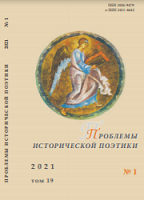В поисках «положительно прекрасного» героя: князь Мышкин Ф. М. Достоевского и Сегелиель В. Ф. Одоевского
In Search of a “Positively Excellent” Hero: Prince Myshkin by F. M. Dostoevsky and Segeliel by V. F. Odoevsky
Author(s): Yuliya N. SytinaSubject(s): Christian Theology and Religion, Studies of Literature, Russian Literature, 19th Century
Published by: Петрозаводский государственный университет
Keywords: F. M. Dostoevsky; V. F. Odoevsky; “positively excellent” hero; tradition; cultural unconscious; archetype; literary roll calls;
Summary/Abstract: The article analyzes the searches conducted by F. M. Dostoevsky and V. F. Odoevsky for a “positively excellent” hero. It compares the images of Prince Myshkin from The Idiot and the hero of the dramatic excerpt Segeliel, or Don Quixote of the XIX century. The similarity between these two characters is reflected as early as in the history of their creation. The authors hypothesize that in both cases an Easter archetype emerges behind the conscious or unconscious desire to substitute a grim and sinful character with a “positively excelent” one. Myshkin and Segeliel love the world with a compassionate, selfless and active love, but they are alien to other people, differ by their very nature and are aware of this otherness. The heroes do not accept the “earthly” hierarchy in relation to people, they are incomprehensible to others and are laughable from the point of view of “common sense.” At the same time, there are numerous differences between them. Segeliel is a spirit, but he is rational, he believes in laws and in science. Myshkin strives for a mystical experience of life. Failures lead Myshkin to humility, and Segeliel to rebellion. Dostoevsky’s hero seeks to flee from the world. Odoevsky’s hero wants to intervene in earthly affairs. Segeliel wants to remake the world without God. He does not believe in the Creator and repines against him. Segeliel’s throwings are reminiscent of the complex dialectic of good and evil, construed by rebels from Dostoevsky’s novels. At the same time, it is important to distinguish the positions of Segeliel and Odoevsky himself, who is not in complete agreement with his hero. Certain common motifs, i.e., those of childhood and foolishness for Christ, create parallels between Myshkin and Odoevsky, the character and the writer. The many intersections between the image of Segeliel, his author and the image of Prince Myshkin allow us to identify the cultural code that appears in the works of Russian writers who sought to find the earthly embodiment of truth, goodness and beauty in a rough physical shell, inevitably hindered by original sin.
Journal: Проблемы исторической поэтики
- Issue Year: 19/2021
- Issue No: 1
- Page Range: 173-193
- Page Count: 21
- Language: Russian

